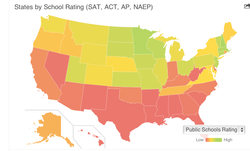
Have you ever wondered if your public school system will do a good job of educating your children? Elite colleges consider your application state when they're building their class list, but have you ever considered what an education in your state means to outsiders? We found the coolest app that will give you just that information! Business Insider compiled the data and put it on an easy to read map so that you can get a quick glimpse of how your public school system is faring.
As you peruse the map, keep a few caveats in mind.
As you peruse the map, keep a few caveats in mind.
- You can use the map to see how your public schools are doing, but you can't make a comparison between states. Why? Because each state defines and runs their public schools based on their own needs and demographics. Comparing state scores is honestly an apples to oranges comparison that should be avoided.
- The map is a better indicator of your public school system if your state is very homogeneous or if you truly understand the diversity present in your state. For example, states like New York have public schools that serve a hugely diverse demographic with a multitude of needs. Approximately 40% of the students speak a language other than English as their primary language and the student data encompasses kids living Upstate, in the Bronx, in Brooklyn, in the Upper East Side, etc. That diversity, coupled with the fact that many of the public high schools are competitive entry - for example Stuyvesant High School has a reputation for producing students who are national leaders in the areas of Science and Math. These scores will pull up the scores from some of the lower performing schools located in Harlem. However, the overall score for a school in Utah (which is very homogeneous compared to the New York demographic) provides a fairly true score average for any student residing in most of the city or suburban schools.
- A stellar state score does not mean your student will be the best educated applicant for every college recruiter seeking scholarly talent. And a poor state score does not mean you cannot receive a decent education in that state. Some states depend on a private school system to educate their students - only underachievers and those who can't afford private schools are in the public school group. Sadly, this means that bright kids who are hungry for a rigorous academic schedule but lacking in financial resources (to pay for a private education) may have a more difficult time attaining their educational goals. But many of them still do just that! If your state is one of the lower ranked states, find out WHY before you flee the state. See what educational alternatives are available, see if there are schools that may be able to better meet your child's needs with some extra transportation, and ask around about how you can work to make a change in the educational ranking of your public school system.
- A stellar state score does not guarantee Junior will graduate with the best education possible. Think about the old adage, you can lead a horse to water but you can't make him drink. Consider that student you are shooing out the door to class every morning. Students have to possess the interest, motivation, and ability to get the most out of a rigorous academic program. They have to be excited about taking the AP courses, willing to forego social time to put in the extra study time required for those courses, and confident in their ability to keep up with the rest of the class. If this isn't your student, relax! Help your student explore options and interests and choose classes that will help with post-graduation job searches or fulfill personal interests in the arts.

 RSS Feed
RSS Feed